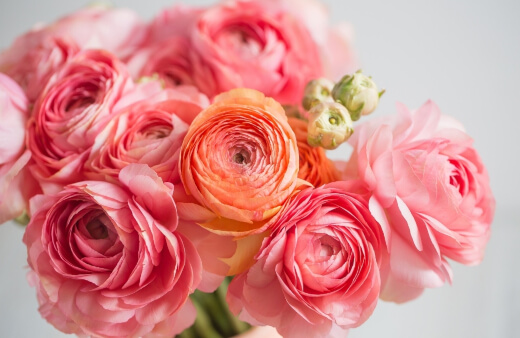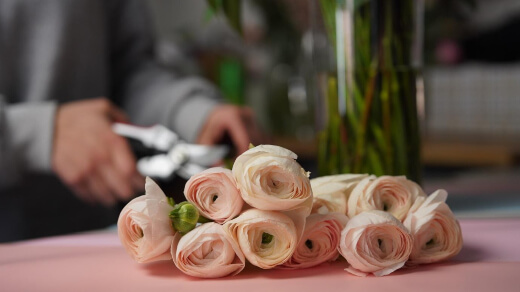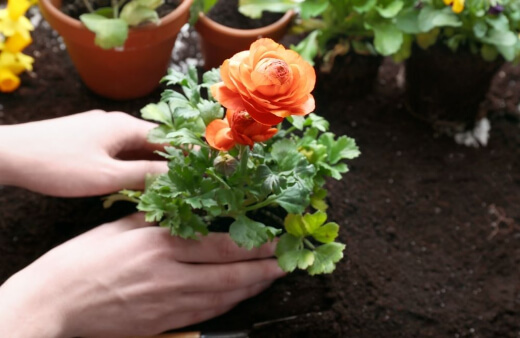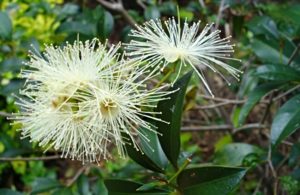Soft, fragrant flowers with tall stems and a long vase life, ranunculus flowers are one of the most popular types of fresh flowers in Australia today. Read on and learn how to grow ranunculus in your garden.
More...
What are Ranunculus?

Ranunculus plants thrive in most places in Australia however they are typically colder climate annuals, best suited to the southern states as well as seasonally in Queensland.
Ranunculus asiaticus, also known as ‘Persian Buttercups’, these stunning flowers come in a wide range of colours and they’re even bi-colour variants, they are high yielding flowers and offer a quick turn around between planting and freshly cut flowers in your living room.
Ranunculus: A Popular Flower Amongst Florists
Parisian buttercups are a favourite amongst local wedding florists for their long stems which stand out in a bouquet with such a wide selection of colours and shades to suit any wedding colour scheme.
When cut at the optimal time, these flowers can last up to ten days in a vase when cared for properly. To get the best out of your ranunculus buds, cut them when the buds are coloured, soft and still closed. If cut once they are open, they will still give up to a week of beautiful fragrances and colour to the room.
Varieties of Ranunculus Flowers
Popular for their high yielding flowers, ranunculus flowers have become a favourite amongst gardeners in the colder states. The choice in colour and shades between the varieties of ranunculus make these flowers a versatile addition to every garden.
You can select from two variants in size, the traditional Giant Tecolote version with long stems and large double flowered blooms, or the Bloomingdale variety, which is smaller than the Giant Tecolote version, with a stronger, shorter stem.
Their elegant flowers in such a wide range of colours, their soft fragrance and long stems makes them a favourite in wedding bouquets, floral displays and household arrangements.
Parisian Buttercups Planting Process

You can grow your own ranunculus flowers using one of 3 methods. Pre-sprouted corms, un-sprouted corms or from seedlings.
The recommended method to grow your own ranunculus is to plant pre-sprouted bulbs that resemble the shape of an octopus, these are called corms.
Pre-sprouted Method
This is the preferred method to yield the best results in the shortest time frame. You can source ranunculus corms from your local gardening shop including most Bunnings.
Choose the largest corm you can find because the larger corms will yield more flowers and larger flowers. Start by soaking the corms in room temperature, fresh water for 3-4hrs. The corms will swell, even doubling in size.
Once soaked you are ready to sprout your corms. To pre-sprout the corms, gather a flat tray and cover the base until halfway up the tray with good quality potting soil, disperse your sprouted corms evenly throughout the tray and cover with remaining potting soil.
Allow to sit for 14 days, checking every few days the moisture level. You want the environment to be moist but not soggy as this will lead to mould and rot. Once sprouted, you will see little white hairs, indicating that the corm is ready to be planted.
Planting Without Pre-Sprouting
You can plant the soaked corms without pre-sprouting, they will take longer to yield results, but they will surely get there. Follow the above soaking directions and then plant the soaked corms directly into your soil mixture.
Planting from Seedlings
Although you can technically plant ranunculus from seedlings, the process is much slower. Follow the instructions on the packaging of your seedlings.
Generally, ranunculus seeds are planted in a tray to germinate with potting soil, they require consistent temperatures between 15-7°C and need to be kept out of direct sunlight and always remain moist.
Ideal Environment for Growing Ranunculus Flowers

Soil
A mixture between high quality, fertiliser and compost will yield the best results for your ranunculus plants. Place the corms around 5cm below the surface of the mixed soil, and cover with remaining soil.
If you live in a colder climate such as Victoria, or Tasmania, you may need to get a frost blanket to cover the garden when temperatures go below freezing.
Water
Ranunculus plants require a lot of water. They need to be in an area with good drainage because they need consistent water, without becoming soggy.
Sunlight
Partial sunlight is ideal for ranunculus plants. Being a colder climate annual flower, once the temperatures increase in spring and summer, these plants will not be able to cope with heat and excess sunlight.
Plant them in an area that gets partial sunlight and will be protected from the sun at the heat of the day.
Temperature
Colder climates with an ideal temperature between 15-7°C will yield the best results for your ranunculus plants. Usually, ranunculus plants are planted in autumn or winter, depending on which part of Australia you live in.
Ranunculus Frequently Asked Questions
Are ranunculus perennials or annuals?
Ranunculus is a perennial species that has adapted to last through hot dormant periods by storing food and nutrients in enlarged root structures. Some varieties are annuals, best suited to cooler climates.
Where is the best place to plant ranunculus?
These blooms prefer a sunny location with rich, well-drained soil. They also do well when planted in raised beds.
Does ranunculus grow well in pots?
These plants perform well in pots, making for stunning additions to container gardens or balcony gardens.
How poisonous are ranunculus plants?
They are considered toxic only if ingested in large quantities. Some more sensitive individuals may experience minor skin irritation when handling these plants.
How long will ranunculus flowers last?
Flowers that are cut before they fully open will usually last for about 10 to 12 days in a vase.
Do ranunculus plants only flower once?
No, these blooms will start in early spring and will continue into the beginning of summer until the plant goes dormant.
Does ranunculus need a lot of water?
These flowers need regular water and moderately moist soil. It is best to water deeply but infrequently, letting the soil dry out in the top 2 to 5 centimetres between waterings. Try to avoid overwatering as the roots are sensitive to excess moisture.
Wrapping Up Our Ranunculus Growing Guide
A versatile, elegant flower with a long vase life, ranunculus flowers are a favourite amongst florists, and now you can grow them in your own garden.
Published on January 3, 2023 by Gary Clarke
Last Updated on February 1, 2024





Hi, I have ranunculus corms to plant in pots. I live in NW Tasmania. Everything I've read on planting time advises to plant them in May, which I'm not able to do. Would it be ok to plant them at the beginning of June?
If so, should I pre-sprout them and plant into pots mid June?
I'm a new subscriber and look forward to learning.
Thank you.
Hi Linda,
They’re much better in the ground than in a bag, so the sooner you can plant them the better.
Ranunculus can be planted any time from late summer to early winter, but as long as you get them in the ground while the soil is still reasonably warm, they should still grow and flower in spring.
The same can be said for most bulbs. If you plant them slightly later than usual one year, they will still flower in spring (or summer depending on the bulb) and will have an even better display the following year.
Best regards,
Gary Clarke
Hi Gary,
Thank you for your reply and information on planting my ranunculus.
I intend to plant them in pots. Another question:
Given the lateness of planting, would you advise pre-sprouting them on a tray, or just soaking them and planting straight into pots?
I've subscribed to the newsletter, and look forward to receiving my two ebooks.
Thank you,
Linda
Hi Linda,
Just get them in the ground. They’re unlikely to flower this year, so the longer they have in their permanent home the better. If you’ve got any, some bulb compost might help them cope with any moisture that can stay in the soil through winter, and stop them from rotting off, but if you don’t have any, just mix in some grit, perlite, or even sand (as long as it’s not “builder’s sand” which can be too alkaline – play sand for kids works fine).
Basically, as long as they’re protected from excess moisture they’ll sprout in spring. You should get some flowers this spring, but they’ll be really well established by the following year and should just keep going after that.
Best regards,
Gary Clarke